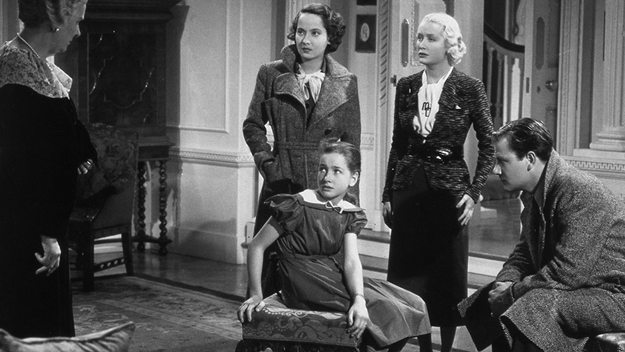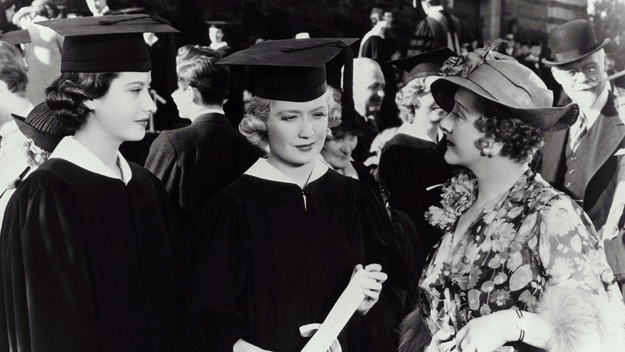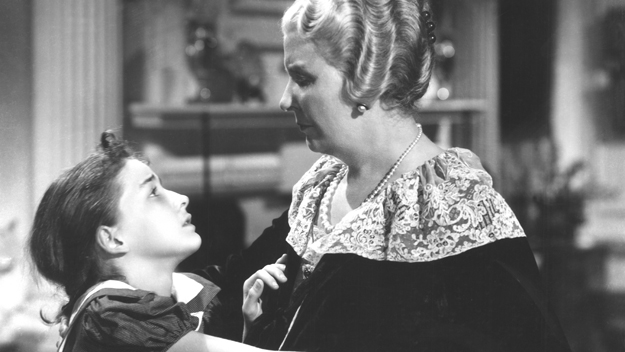Queer & Now & Then: 1936
In this biweekly column, Michael Koresky looks back through a century of cinema for traces of queerness, whether in plain sight or under the surface. Read the introductory essay.

Images from These Three (William Wyler, 1936)
These two, Martha and Karen, are fresh from graduating a women’s college in New England. We don’t know much about them yet, but it’s clear from the start that these bosom buddies share an easy intimacy. Packing up their dorm room, they dream of their future while sprawled out, inhabiting their space with a casual, physical chemistry that can only come from cohabitation. The young women have little money to their name, but drive, gumption, and ambition in spades—and something else: a bond that makes them more powerful as a pair. “Maybe we could live somewhere together,” imagines Martha wistfully, and since it’s said by pinpoint precise, no-nonsense Miriam Hopkins, you believe she wants this more than anything. Karen, played by brunette Merle Oberon, unavoidably cosmopolitan in bearing and confidence, responds that Martha should come with her to her family’s abandoned farmhouse, which they can remake and refurbish into a girls’ school: “Take a chance with me and come . . . take a chance with me.” It’s like the beckoning to a lover, a leap of faith with a twinge of romance, and who could say no?
If one is aware of the source material for William Wyler’s 1936 film These Three, one might expect the obvious adoration between Martha and Karen to be more fully explored. Yet this tightly focused, rigorously transformed adaptation of Lillian Hellman’s The Children’s Hour manages to keep the original play’s structure, template, and mood of escalating hysteria while altering the central point of the story, which stems from the fear of sexual transgression. In Hellman’s 1934 play, inspired by an incident that occurred in a girls’ school in Edinburgh in the early nineteenth century, headmistresses Martha and Karen are accused by a troubled, vindictive child of carrying on a sordid lesbian affair. It’s a claim that makes things particularly complicated for Karen’s engagement with a local doctor named Joe. These Three maintains and centralizes this triangle: in Wyler’s film, Martha is accused by the brat of having had a sexual encounter with Joe (Joel McCrea) under the school’s roof, which is apparently shocking enough that every child is summarily evacuated from the school by their mortified parents.
The film is thus neutered, but it’s not defanged: in the most literal terms, These Three is about a heterosexual scandal that reveals a brutal American puritanism eager to destroy anyone who deviates from the playbook of acceptable social convention. These Three is also fascinating, however, for how its recalibrated tale of lies and accusations maintains traces of its original text. Because of its provenance, Wyler’s film is often talked about in terms of erasure, perhaps mentioned in the same breath as Ernst Lubitsch’s Design for Living (starring a pre-Code Hopkins) or Edward Dmytryk’s Crossfire or Richard Brooks’s Cat on a Hot Tin Roof, other films that either lessened or eliminated gay subplots, subtext, or characters. Yet These Three, which featured a screenplay adapted by Hellman herself, allows for the subtle shifting of its queer presence as opposed to just being a reflection of its absence. The Children’s Hour cannot be denied, nor completely erased, like the still detectable marks on a chalkboard from some previous lesson. Even the original poster for These Three seemed to be playing off viewers’ foreknowledge of the original play, boasting the tagline, “Tortured by a suppressed love!”

In 1936 Hollywood, where the long-standing Motion Picture Production Code had only a couple years prior been enforced anew by known anti-Semite and right-wing maniac Joseph Breen, there was no other way for this adaptation to exist. Hellman had been in and out of the movie business for most of the decade, starting with a stint reading scripts for MGM. The astronomical, yet controversial success of The Children’s Hour on Broadway (one was technically not allowed to explicitly refer to homosexuality on-stage there, but in New York everyone tacitly agreed to look the other way) made the outspoken Jewish leftist Hellman more of a known quantity when she returned to Los Angeles. Soon enough she was in the stable of writers working for exacting producer Samuel Goldwyn, along with such scribes as George Hecht, Frances Marion, and Robert Sherwood. Her first major job for Goldwyn was on a wartime love triangle titled The Dark Angel, starring Oberon, Fredric March, and Herbert Marshall; she called it “silly,” but she was committed to the work, and the film went on to considerable success, including a Best Actress Oscar nomination for Oberon. The process was not without its struggles, however, as the script wouldn’t pass code without severe rewrites, including the deletion of many of Hellman’s sexual innuendos.
Since Hellman had already been through the humiliating process with Breen’s Production Code office, she wasn’t surprised when, after Goldwyn bought the rights to The Children’s Hour for $40,000, Breen immediately informed the studio that this hot property would likely have to be altered beyond recognition. Even the title would require changing, as the play—which was still being performed in New York and would continue its run even after the film version was released—was too well known, its name already a kind of shorthand for its lurid lesbianism. The Production Code strictly forbade any instances or implications of “sex perversion,” of which The Children’s Hour, with its references to “unnatural acts” between women, was perceived as being a unique example. According to the code, adultery could only be represented if properly condemned; homosexuality was different in that it could not even be referred to. Thus it didn’t matter that, in Hellman’s play, homosexuality is presented as a social stigma and leads to a tragic denouement in which Martha kills herself, after ultimately admitting her long-suppressed feelings for Karen. Of course, this could never be dramatized, even obliquely, because, according to Hollywood, at least as it presented itself, gayness simply didn’t exist.
Hellman knew this wasn’t a battle she could win and summarily made the proper adjustments, transforming the retitled These Three into a tale of three well-meaning straight people undone by gossip. She recommended Wyler, then a newcomer, to a less-than-convinced Goldwyn; the producer feared he might be too green, but she had seen his John Barrymore vehicle Counsellor at Law and was certain he’d be right for the job. Indeed, Wyler—who would go on to direct his masterful, ambivalent marriage story Dodsworth in the same year—is such a master of space, timing, and mood that he envelops the viewer in this lesson in gossip and injustice, despite the fact that the stakes feel so much lower than in the source material. This is also thanks in no small part to the evocative lighting and compositions of cinematographer Gregg Toland, who effortlessly brings out the tensions among the trio of wronged characters, often seen having hushed after-hours conversations in claustrophobic upstairs bedrooms.
While Wyler’s film downplays the implicit hothouse atmosphere of the same-sex boarding school setting—so classically exploited for homoeroticism in cinema from Mädchen in Uniform (1931) to Olivia (1951) to Tea and Sympathy (1956)—he does cede much of the floor to one of the children: the lying and loose-lipped pupil Mary Tilford, the cause of all the distress. Not at all sympathetically drawn, Mary nevertheless engenders a kind of humane curiosity; with no clear psychological reading, she’s given little motivation for her unruly and malicious behavior, outside of the fact that she seems to have been raised in blinkered privilege by a wealthy, spoiling grandmother, Mrs. Amelia Tilford (Alma Kruger). She exists in opposition to Martha and Karen, who claim to have 38 dollars between them when they graduate school and try to start out together. Martha, especially, seems to have had a peripatetic childhood, leading not to disillusionment but altruism, saying she wanted to be a schoolmistress because, “Being young is awfully hard and I wanted to make it easier for other kids growing up.” Mary is unlikely to be the kind of little girl Martha is talking about, though she clearly would have benefited from some kind of guidance.

This bad seed is embodied with a remarkable mix of sadism and self-loathing by young actress Bonita Granville, whose wan countenance, hangdog butch demeanor, and tousled dark ponytail provocatively contrast her with the school’s menagerie of rosy-cheeked blonde girls. Nasty though she may be, Granville holds the screen with her impenetrable thousand-yard stare; she so fully embodies a refutation of “sugar and spice” feminine expectation that, looked at through a different lens, she becomes a kind of stealth protagonist, a queer disruptor intent on shaking up the status quo. This character functions wholly differently from the original stage version of Mary, whose nefarious processes are more in line with a stifling social conservatism; by eradicating the lesbian element of the story, the film allows Mary to be more of an enjoyable villain. The virtuosic Granville’s centrality to the film was apparent even on set, so upsetting Oberon and McCrea that they complained to Goldwyn that Wyler was showing her character too much preference. The actors’ egos may have been over-bruised, but their paranoia wasn’t completely unfounded: the 13-year-old Granville was the only actor from the film to receive an Oscar nomination, included in the lineup for Best Supporting Actress the year the award was invented.
In The Children’s Hour, the “lie” about Karen and Martha reveals a hidden “truth”—Martha’s unrequited feelings for Karen—which in turn reveals the “unnatural” element that must be eradicated. Without Mary’s fear-mongering to prop up the story’s sense of urgency, These Three must persuade as pure melodrama, which Wyler achieves nimbly. The truth beneath the lie in Wyler’s film is that Martha’s repressed forbidden desires are for Joe rather than Karen. Wyler’s way of telegraphing this is simple and touching. During the night that Mary claims to have seen something bad happening between them, Joe and Martha share a pleasant, late-night conversation in a quiet room upstairs at the boarding school. As he nods off, Martha touches the hand of her friend’s fiancé gracefully and whispers, “Sleep well, Joe.” The camera tracks towards Martha as she sits in a chair by the window; outside snow silently falls. The screen dissolves, yet we’re still in the same scene, only later. The camera moves back to reveal Martha in the same chair, but she’s still awake, her gaze fixed on Joe as he sleeps. This meditative moment, the film’s last, is disrupted when he suddenly jerks out his slumber violently and knocks over glass of milk. With a quick cutaway, we see this has startled Mary out of her sleep in an adjacent room, inciting the drama of sin and slander that overtakes the rest of the film.
It’s this kind of visual expressiveness that would be missing from Wyler’s own 1961 remake, which reverted back to Hellman’s original title. Though loosening standards in the Production Code meant that he could be more faithful to the original text, The Children’s Hour is a far more leaden experience, attempting a black-and-white psychological realism in keeping with the era’s succession of overwrought theater adaptations, and featuring tortured, histrionic performances by Audrey Hepburn and Shirley MacLaine, who somewhat infamously screams about her own homosexuality: “I feel so damn sick and dirty I can’t stand it anymore!” Groundbreaking though it may have been for explicitly engaging with queer identity, and for containing an essentially sympathetic lesbian protagonist, this notorious version feels more like the fossil. This is not because the film has no contemporary relevance—reputations can perhaps be even more easily ruined today than ever, whether unfounded or not—but because its literal presentation and compositional flatness leave no room for subtext.
In both versions, Mary’s lies are revealed and all are exonerated of suspicion. Yet at the end of The Children’s Hour, Martha nevertheless hangs herself out of despair and self-loathing. Near the end of These Three, however, little Mary gets slapped across the face by Margaret Hamilton, who appears in a brief but stinging role as Mrs. Tilford’s housekeeper, just three years before The Wizard of Oz. Just desserts at the hands of the Wicked Witch of the West—now that’s queer visibility I can get behind.
Michael Koresky is a writer, editor, and filmmaker in Brooklyn. He is cofounder and editor of the online film magazine Reverse Shot, a publication of Museum of the Moving Image; a regular contributor to the Criterion Collection and Film Comment, where he writes the biweekly column Queer and Now and Then; and the author of Terence Davies, published by University of Illinois Press, 2014.







